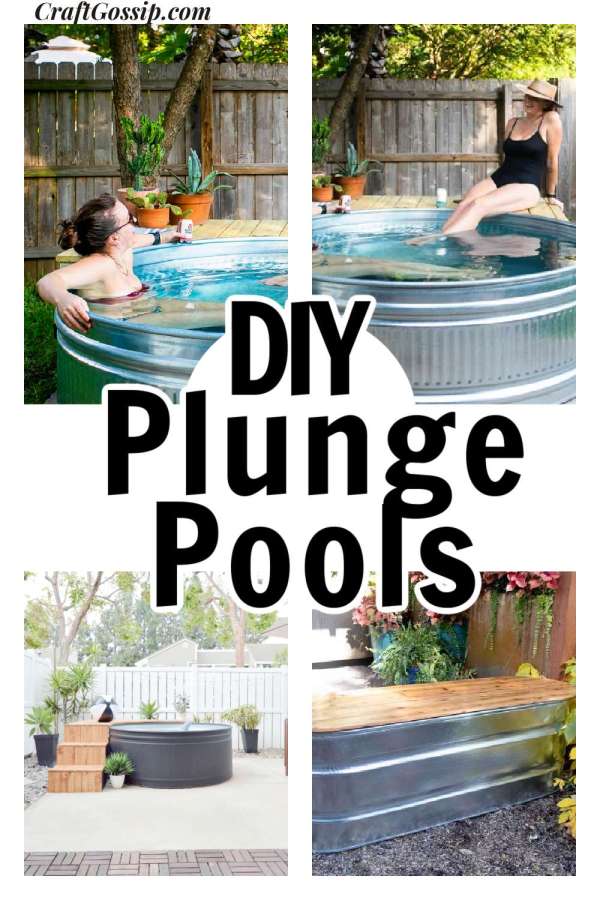
Get ready to cool off in your very own plunge pool with these DIY tutorials!
Building your own plunge pool is a great option for those who want to save money and space while still being able to relax on a hot summer day. Big pools are over-rated and in summer you just want to cool off, not swim 10 miles back and forth or dump dive over and over again. Our dog uses our pool more than our children, so for the next house, we will be 100% downsizing to a smaller plunge pool concept. We just need a pool to sit and drink mojitos in.
Here are some tips and ideas to help you get started
What Is a Plunge Pool? Plunge pools are smaller pools designed for soaking, wading, or cooling off, and are typically 10×20 feet around and 6 feet deep. They are low maintenance and have risen in popularity in recent years due to their ease of use and low cost.
How Much Does a Plunge Pool Cost? On average, installing a plunge pool costs $20,000. However, DIY plunge pools can be built for much less, and above-ground plunge pools typically do not require permits.
Benefits and Drawbacks of Building a DIY Plunge Pool Some benefits of building a DIY plunge pool include its low cost, little space required, and ability to be modified to fit your budget and needs. However, there are some downsides to consider, such as not being big enough to swim laps and needing to invest in a submersible pump if drainage is an issue.
The Location of Your Plunge Pool Is Key When planning your DIY plunge pool, it’s important to choose the right location. This will impact filling and draining your pool, as well as any additional permits or liability steps you may need to take.
Different Types of Plunge Pools There are several types of plunge pools to choose from, including in-ground, above-ground, concrete, and fiberglass plunge pools. You can also opt for a plunge pool/hot tub combo or cold plunge pool, depending on your preferences.
Some of the most popular DIY plunge pools at the moment are Stock tank pools. So I am going to focus on those, mostly because they are far more affordable for the average DIYer to make.
Stock Tank Pool A great guide from Maker Gray.
Want to share in the process? Check out this “in progress stock tank installation ready for summer. Okat this tutorial is actually for a stock tank storage box, but I love the idea of the smaller tank for a bath like plunge pool, this is much better for singles or couples as its faster to heat with an electric immersion heater or add ice to for an ice bath.
I love the style of this one, the black really gives it a cool chic vibe, I am also going to assume the black would make it warmer too as black absorbs the heat from the sun.
If you’re looking for some more inspiration, here are four DIY plunge pool ideas to get you started:
- Above-ground plunge pool using a stock tank
- Natural-looking plunge pool using an upcycled wood pallet
- Plunge pool from a stock tank Video -The cost of making a plunge pool from a stock tank can vary depending on several factors, including the size of the tank, the materials you use to build the pool surround, and any additional features you may want to add, such as a heater or filtration system.On average, you can expect to spend between $1,500 to $3,500 for a DIY plunge pool made from a stock tank. This estimate includes the cost of the stock tank, any necessary equipment, and the materials needed to build the pool surround. However, keep in mind that these costs can vary depending on your location and the availability of materials.
- Home Depots version with video tutorial
With these tips and ideas, you’ll be well on your way to creating your own DIY plunge pool and enjoying a refreshing dip whenever you need it. Happy building!
FAQs for making your own DIY Plunge pool
Q: What is a DIY plunge pool?
A: A DIY plunge pool is a smaller-sized pool designed for soaking, wading, cooling off, or even sometimes for water aerobics or muscle rehabilitation that you can build yourself at home.
Q: How much does it cost to build a DIY plunge pool?
A: The cost to build a DIY plunge pool varies depending on the type of pool you choose to build, but on average, it can cost around $20,000 if creating a concrete one or less for a stock tank.
Q: What are the benefits of building a DIY plunge pool?
A: There are several benefits to building a DIY plunge pool, including requiring little space, being built to fit in most types of yards, saving money on installation costs, having fewer ongoing maintenance costs, and being a great way to exercise.
Q: What are the drawbacks of building a DIY plunge pool?
A: The main drawback of building a DIY plunge pool is that it may not be big enough to swim laps, and installing concrete may be difficult for some homeowners. Elegant or combo designs may also be hard to build yourself.
Q: What are the different types of plunge pools?
A: There are several types of plunge pools, including in-ground plunge pools, above-ground plunge pools, concrete plunge pools, fiberglass plunge pools, plunge pool/hot tub combos, and cold plunge pools.
Q: Do you need a permit to build a DIY plunge pool?
A: It depends on the type of pool you choose to build. Above-ground plunge pools usually don’t require a permit, but in-ground plunge pools do.
Q: How often should you drain a plunge pool?
A: It is recommended to drain your plunge pool every five years to prevent dirt and debris build-up and reduce Total Dissolved Solids. In a plunge pool, draining and refilling your pool once every year or two is more reasonable from a cost perspective.
Q: What is the most cost-conscious type of dipping pool you can build yourself?
A: The most cost-conscious type of dipping pool you can build yourself is an above-ground plunge pool, which usually doesn’t require a permit and can save you $400 to $1,800 alone.
How to heat a plunge pool?
If you are like me then you like your showers hot and your pools warm…
There are several ways to heat a stock tank pool, including:
Solar stock tank pool covers: These are designed to capture the sun’s heat and transfer it to the water in your pool.
Electric heaters: These are typically installed on the outside of the stock tank and use electricity to heat the water.
Propane heaters: These are also installed on the outside of the stock tank and use propane gas to heat the water.
Heat pumps: These are a more energy-efficient option that use electricity to transfer heat from the air or ground to the water in the pool.
DIY solutions: Some people use black tubing or a DIY solar heater made from a garden hose coiled in the sun to heat their stock tank pool.
It’s important to note that the effectiveness of these methods will depend on the size of your stock tank pool, the ambient temperature, and the level of insulation or covering you have on the pool. It’s always a good idea to consult a professional if you’re not sure which option is best for you.




